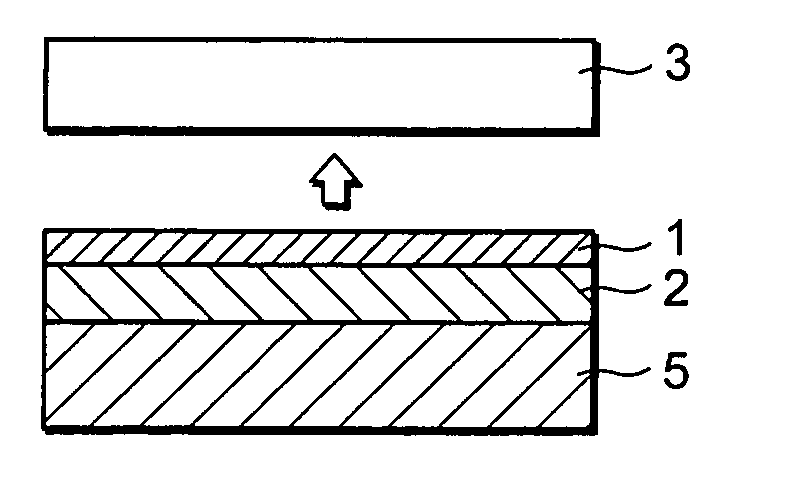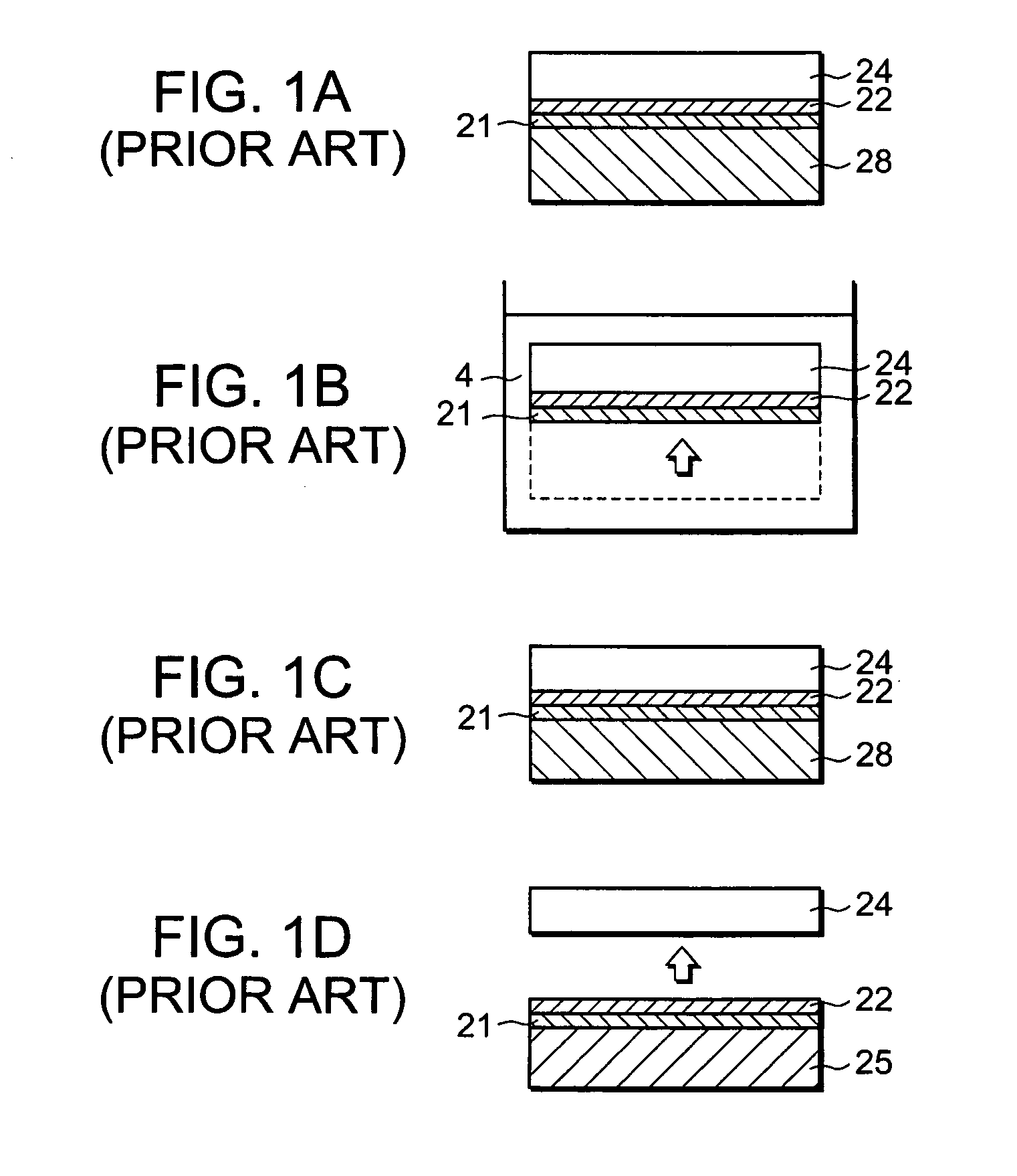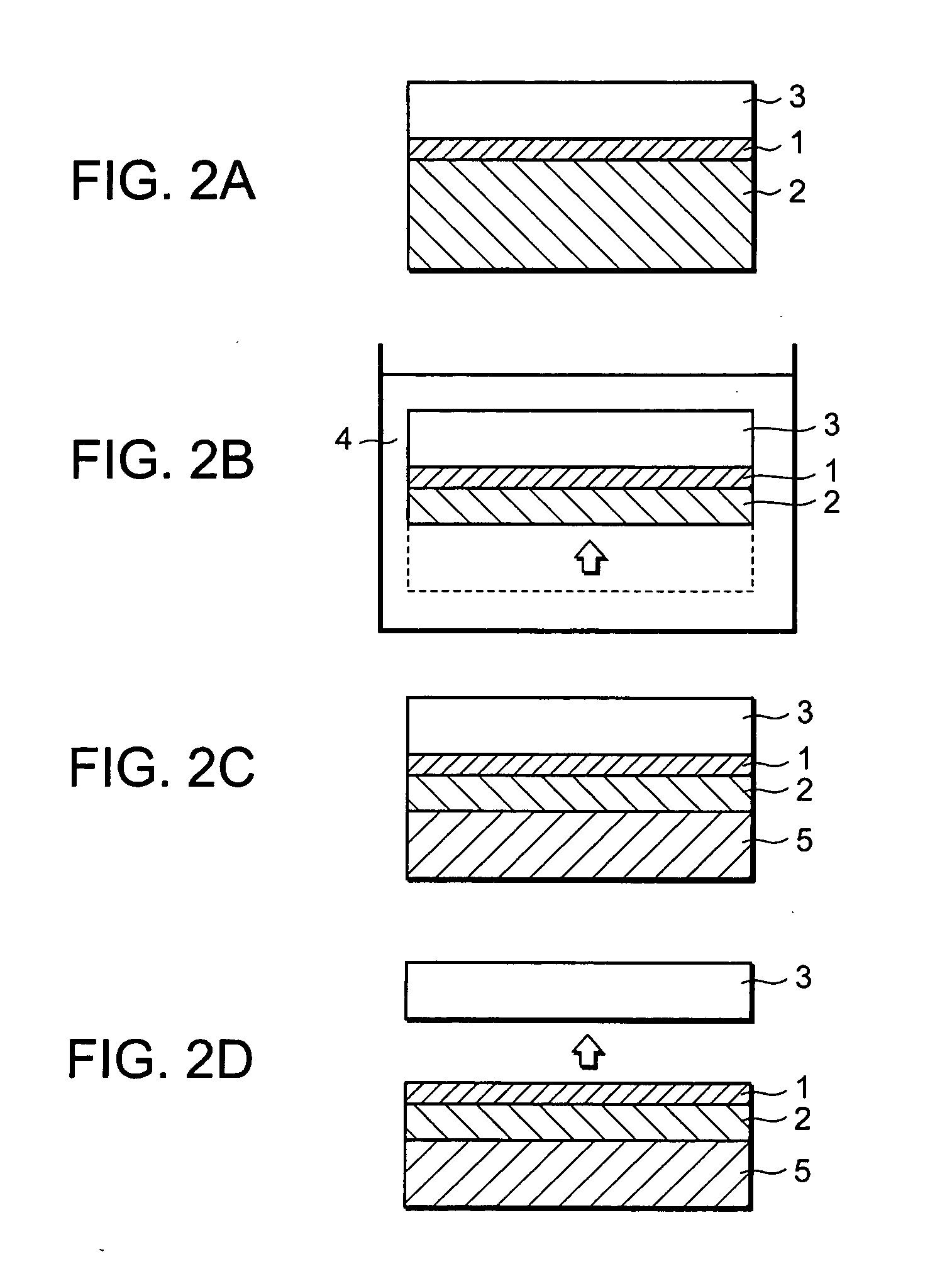Production method of flexible electronic device
a production method and electronic device technology, applied in the direction of laminating printed circuit boards, semiconductor/solid-state device details, instruments, etc., can solve the problems of increasing production costs, card bending force, chip damage, etc., and achieves excellent heat liberation characteristics and toughness, low cost, and high reproducibility.
- Summary
- Abstract
- Description
- Claims
- Application Information
AI Technical Summary
Benefits of technology
Problems solved by technology
Method used
Image
Examples
first embodiment
[0031]FIGS. 2A to 2D are the schematic sectional views illustrating a production method of a flexible electronic device involved in the present invention. As FIG. 2A shows, a protection film 3 is adhered onto the device formation surface (the front surface) of a glass substrate 2 on which a thin film device 1 is formed. Successively, as FIG. 2B shows, the substrate 2 is subjected to etching from the back surface by soaking in an etching solution 4. On the basis of the etching rate determined beforehand, the etching is terminated when a desired residual thickness of the substrate is reached. Thus, the residual thickness is made to be larger than 0 μm and not larger than 200 μm. In this connection, it should be noted that if the residual thickness of the substrate 2 vanishes, the characteristics of the thin film device are degraded, and if the residual thickness is larger than 200 μm, no sufficient flexibility can be achieved. Furthermore, as FIG. 2C shows, a flexible film 5 is adhere...
second embodiment
[0033] Now, description will be made below on the present invention.
[0034]FIGS. 3A and 3B illustrate the second embodiment. FIG. 3A illustrates a case where in place of the flexible film 5 in FIG. 2C, a highly thermally conductive film 6 having a thermal conductivity higher than 0.01 W / cm·deg is used, while FIG. 3B illustrates a case where in place of the flexible film 5 in FIG. 2C, a laminated film made of an insulating flexible film 7 and the highly thermally conductive film 6. The vertical order of the insulating flexible film 7 and the highly thermally conductive film 6 may be reversed. In this connection, the value of 0.01 W / cm·deg refers to a thermal conductivity of a glass, and the use of a film having a thermal conductivity higher than this value improves the heat liberation characteristics of a flexible thin film transistor device. As examples, a copper film (thermal conductivity=4.0 W / cm·deg) and a gold film (thermal conductivity=2.3 W / cm·deg) were used as the highly therm...
third embodiment
[0036] Now, description will be made below on the present invention.
[0037]FIGS. 5A to 5E show a production method of a flexible display device involved in the third embodiment. As FIG. 5A shows, at the beginning, a protection film 11 is adhered onto a glass plate 9 of a display device having a structure in which a display element 8 is sandwiched between a pair of a glass substrate 9 and a glass substrate 10. Successively, as FIG. 5B shows, the thus treated display device is soaked in a hydrofluoric acid based etching solution 12 to etch the glass substrate 10. On the basis of the etching rate determined beforehand for the glass substrate 10, the etching is terminated when the residual thickness of the glass substrate 10 reaches a desired value. The residual thickness of the glass substrate 10 is adjusted to be larger than 0 μm and not larger than 200 μm. Then, as FIG. 5C shows, a flexible film 13 is adhered onto the etched surface of the glass substrate 10, and the protection film 1...
PUM
| Property | Measurement | Unit |
|---|---|---|
| residual thickness | aaaaa | aaaaa |
| residual thickness | aaaaa | aaaaa |
| residual thicknesses | aaaaa | aaaaa |
Abstract
Description
Claims
Application Information
 Login to View More
Login to View More - R&D
- Intellectual Property
- Life Sciences
- Materials
- Tech Scout
- Unparalleled Data Quality
- Higher Quality Content
- 60% Fewer Hallucinations
Browse by: Latest US Patents, China's latest patents, Technical Efficacy Thesaurus, Application Domain, Technology Topic, Popular Technical Reports.
© 2025 PatSnap. All rights reserved.Legal|Privacy policy|Modern Slavery Act Transparency Statement|Sitemap|About US| Contact US: help@patsnap.com



